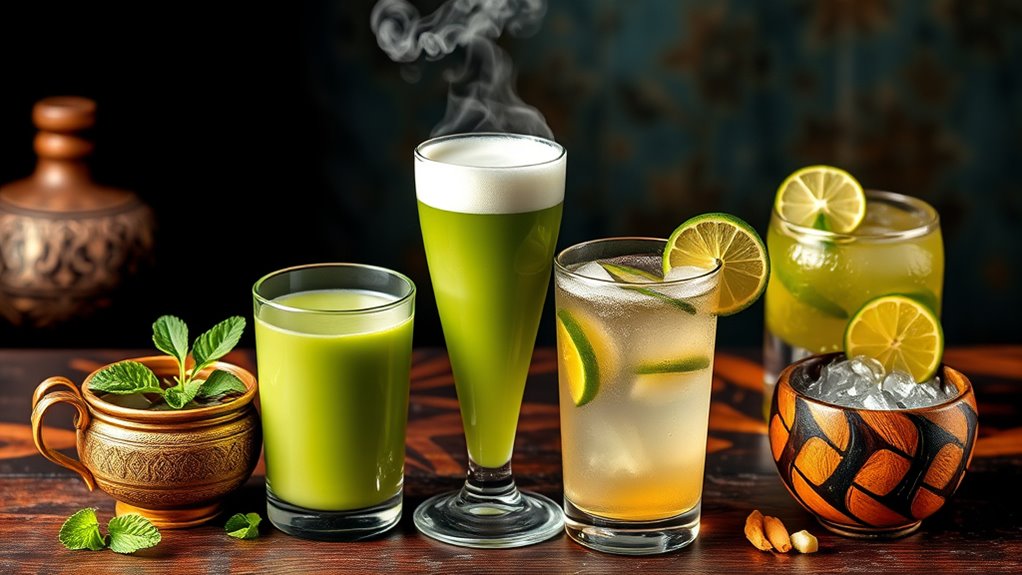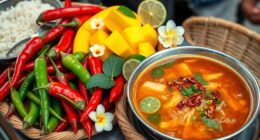Traditional drinks from around the world reflect deep cultural roots, histories, and customs. You’ll find beverages like sake in Japan signifying harmony, yerba mate in South America symbolizing friendship, and palm wine in Africa playing a role in festivals. These drinks often involve traditional brewing techniques and unique vessels, embodying regional craftsmanship. Exploring these drinks reveals stories of communities and centuries-old traditions—if you keep exploring, you’ll discover even more fascinating cultural connections.
Key Takeaways
- Traditional drinks reflect the cultural history, customs, and rituals of different regions worldwide.
- Examples include sake in Japan, yerba mate in South America, and mead in Europe.
- Many are crafted using age-old techniques passed down through generations.
- These beverages often play roles in festivals, ceremonies, and social bonding.
- Appreciating these drinks offers insights into regional identities and cultural heritage.

Across the globe, traditional drinks reflect the rich cultures and histories of their regions. When you explore these beverages, you’re not just tasting flavors; you’re immersing yourself in centuries-old stories passed down through generations. Each sip offers a glimpse into the customs, rituals, and lifestyles of the people who created them.
Traditional drinks embody cultural stories and rituals, offering a taste of history with every sip.
For example, in Japan, you might encounter sake, a rice wine often enjoyed during celebrations and ceremonies. Its delicate flavor and smooth texture symbolize harmony and respect, making it more than just an alcoholic drink—it’s a cultural emblem.
Moving to South America, yerba mate stands out as a social staple in countries like Argentina and Uruguay. You might find yourself sharing a gourd of this bitter herb infusion with friends, symbolizing friendship and community. Drinking mate is a ritual, a way to connect and engage with others, emphasizing the importance of relationships in these societies.
In Africa, traditional drinks such as palm wine and millet beers carry deep cultural significance. These beverages are often part of religious ceremonies, festivals, and communal gatherings. You could find yourself participating in a celebration, raising a glass of locally brewed palm wine to honor ancestors or mark milestones.
The process of making these drinks often involves craftsmanship handed down through generations, giving you an appreciation for the skills and traditions embedded in their preparation. Additionally, many of these beverages are served in traditional serving vessels, which further enhances the cultural experience.
Heading to Europe, you might encounter drinks like mead—an ancient fermented honey beverage that dates back thousands of years. If you’re in Scandinavia or the British Isles, sampling mead connects you to Viking history and medieval festivities. Its sweet, floral notes remind you of the region’s age-old love for hearty, warming drinks.
In the Middle East, arak offers a unique tasting experience. Usually distilled from grapes or dates and flavored with anise, arak is often diluted with water before drinking, turning a cloudy white. When you do this, you’re participating in a tradition that emphasizes hospitality and shared moments.
Across Asia, spirits like baijiu in China or soju in Korea showcase regional distillation techniques, each carrying distinct flavors and cultural meanings. These drinks are often consumed during festivities, symbolizing prosperity and good fortune.
When you sip these beverages, you’re not just tasting alcohol—you’re participating in centuries of cultural practices that celebrate life, community, and heritage. Exploring these traditional drinks invites you to understand and appreciate the diverse ways people around the world toast to shared joys, mark significant events, and preserve their histories through liquid traditions.
Frequently Asked Questions
What Are the Origins of Each Traditional Drink?
You’re curious about the origins of traditional drinks. Each one has a rich history rooted in its culture. For example, sake comes from Japan’s ancient rice fermentation practices, while tequila originated in Mexico’s agave fields.
Other drinks like champagne from France and whiskey from Ireland also have centuries-old stories. Exploring these origins reveals how local resources, history, and rituals shape each beverage’s unique identity across the globe.
Are These Drinks Suitable for All Ages?
You might wonder if these traditional drinks are suitable for all ages. Generally, many are enjoyed by people of different ages, but some contain alcohol, making them unsuitable for children or those avoiding alcohol.
Always check the ingredients before offering a drink to someone younger or with specific health concerns. Non-alcoholic versions or special beverages can be great alternatives, allowing everyone to enjoy the cultural experience safely.
How Are These Drinks Traditionally Prepared?
You might wonder how these drinks are traditionally prepared. Typically, each drink follows specific cultural recipes passed down through generations.
For example, you might mix ingredients like herbs, fruits, or grains, often involving fermentation or special brewing techniques. You usually adhere to traditional methods, with careful attention to proportions and methods, sometimes using special tools or local ingredients.
This process guarantees the authentic flavor and cultural significance of each beverage.
Do These Drinks Have Cultural or Religious Significance?
You’ll find that many traditional drinks hold deep cultural or religious significance. They often symbolize important rituals, celebrations, or beliefs within communities.
For instance, some drinks are used in religious ceremonies or mark special life events. By sharing these beverages, you connect with the history and identity of a culture.
Understanding their significance helps you appreciate how these drinks go beyond taste, embodying tradition, spirituality, and community values.
Are These Drinks Available Worldwide Today?
You might wonder if these drinks are available worldwide today. The answer is yes, many traditional beverages have become globally accessible through international markets, specialty stores, and online shops.
While some are more common, like coffee and tea, others remain regional but can still be found in specialty stores or upscale restaurants worldwide. So, whether you’re in New York or Tokyo, you can often find these traditional drinks to enjoy.
Conclusion
Now that you’ve explored these traditional drinks, imagine yourself savoring each unique flavor from different cultures. Isn’t it fascinating how a simple beverage can tell a story of history, customs, and identity? By trying these drinks, you connect with people worldwide, experiencing their traditions firsthand. So, why not open your mind and palate to these global flavors? After all, isn’t life richer when you embrace the diverse tastes that make our world so vibrant?









